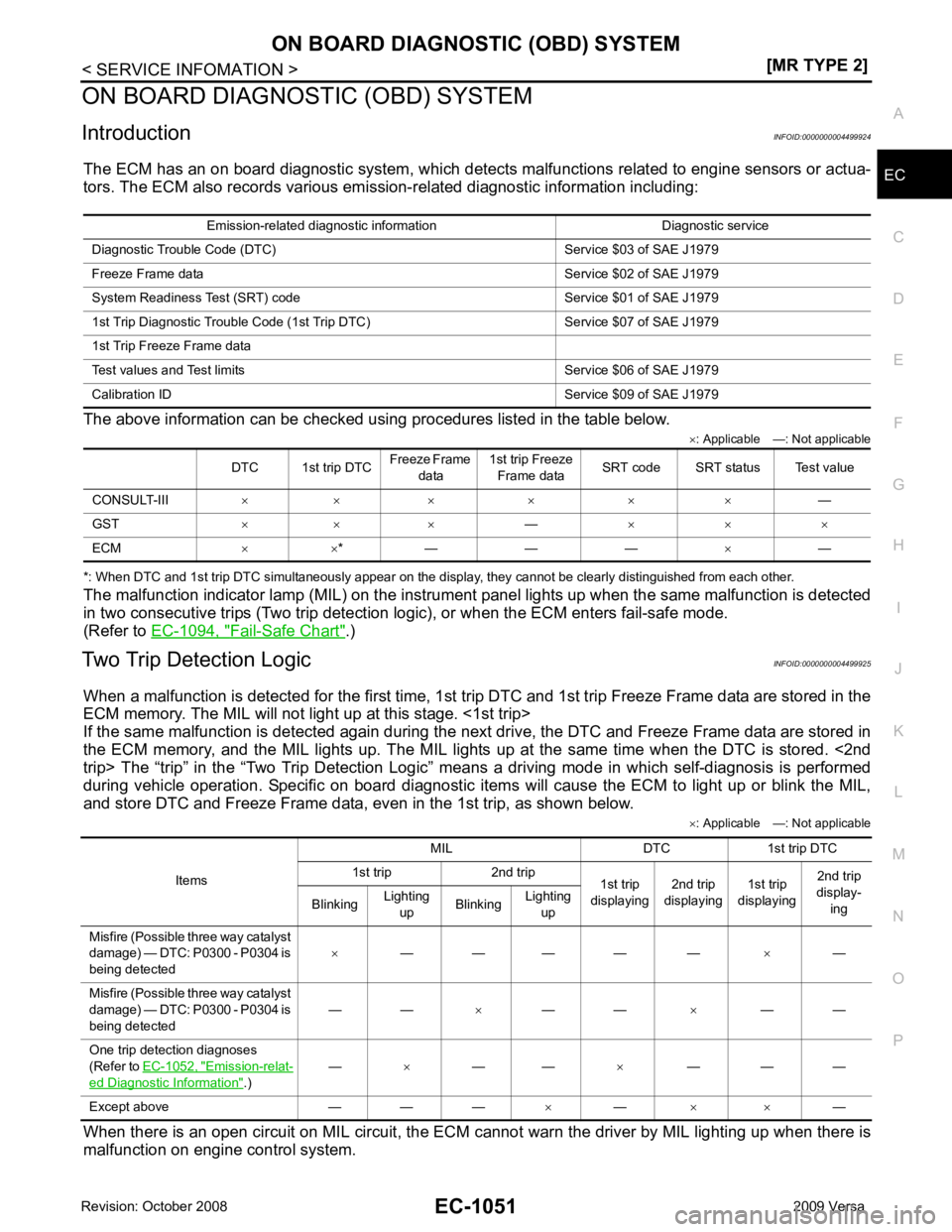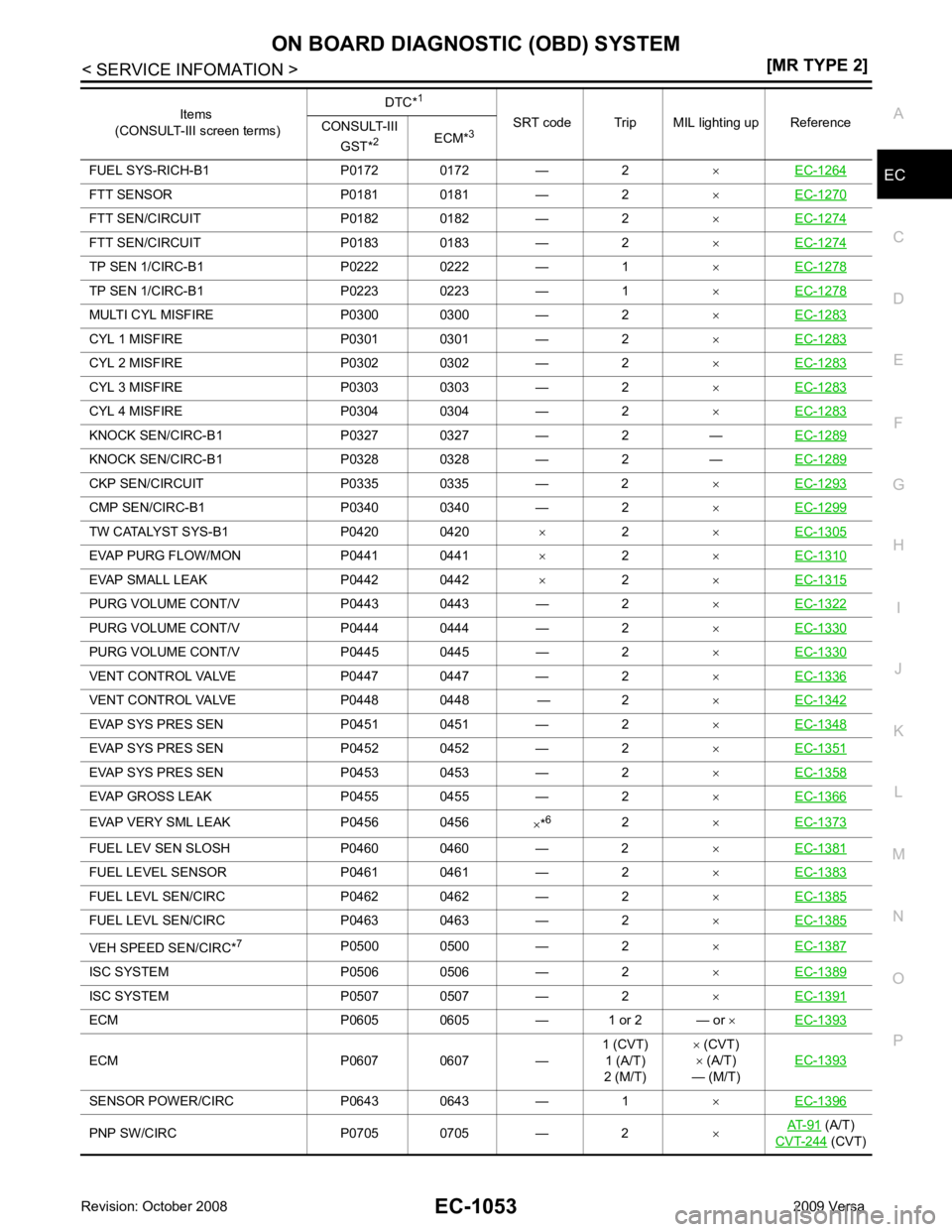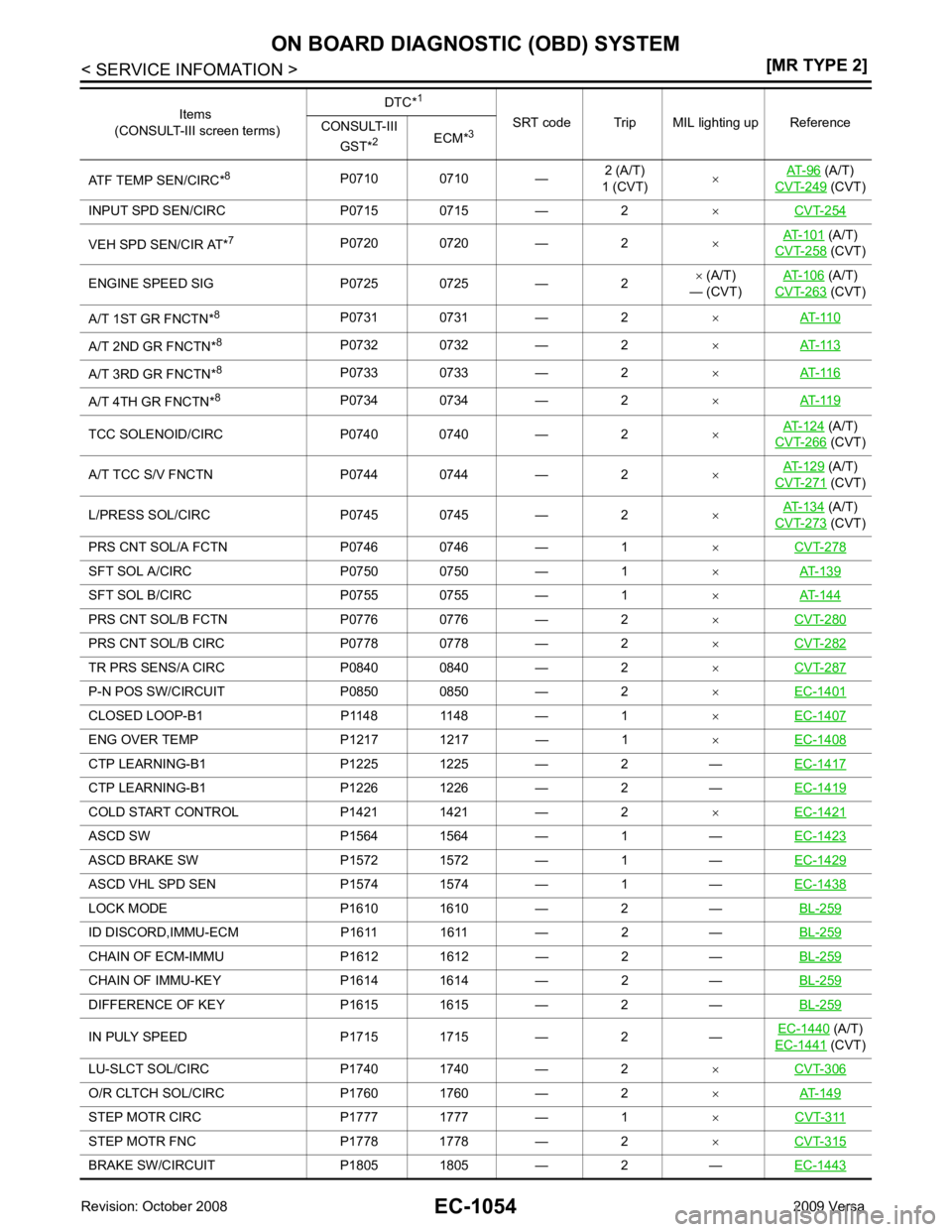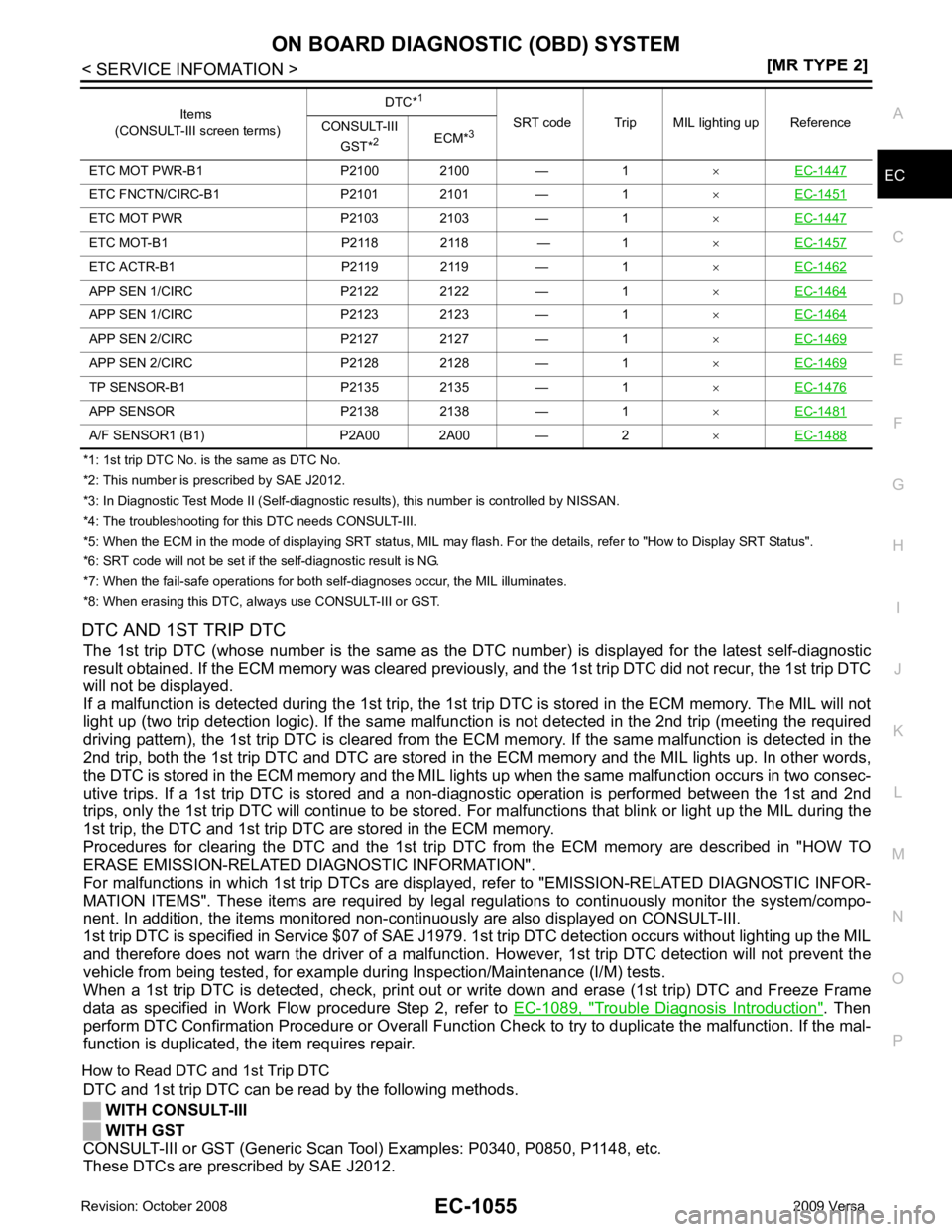2009 NISSAN TIIDA e control
[x] Cancel search: e controlPage 2396 of 4331
![NISSAN TIIDA 2009 Service Repair Manual EC-1040< SERVICE INFOMATION >
[MR TYPE 2]
EVAPORATIVE EMISSION SYSTEM
Positive pressure is delivered to the EVAP system through the EVAP
service port. If fuel vapor leak age in the EVAP system occurs, NISSAN TIIDA 2009 Service Repair Manual EC-1040< SERVICE INFOMATION >
[MR TYPE 2]
EVAPORATIVE EMISSION SYSTEM
Positive pressure is delivered to the EVAP system through the EVAP
service port. If fuel vapor leak age in the EVAP system occurs,](/manual-img/5/57398/w960_57398-2395.png)
EC-1040< SERVICE INFOMATION >
[MR TYPE 2]
EVAPORATIVE EMISSION SYSTEM
Positive pressure is delivered to the EVAP system through the EVAP
service port. If fuel vapor leak age in the EVAP system occurs, use a
leak detector to locate the leak.
Removal and Installation INFOID:0000000004499916
EVAP CANISTER
Tighten EVAP canister as shown in the figure.
EVAP CANISTER VENT CONTROL VALVE
1. Turn EVAP canister vent control valve counterclockwise.
• Lock (A)
• Unlock (B)
2. Remove the EVAP canister vent control valve.
Always replace O-ring with a new one.
How to Detect Fuel Vapor Leakage INFOID:0000000004499917
CAUTION:
• Never use compressed air or a high pressure pump.
• Do not exceed 4.12 kPa (0.042 kg/cm 2
, 0.6 psi) of pressure in EVAP system.
NOTE:
• Do not start engine.
• Improper installation of EVAP service port adapter to the EVAP service port may cause a leak.
WITH CONSULT-III
1. Attach the EVAP service port adapter securely to the EVAP service port.
2. Also attach the pressure pump and hose to the EVAP service port adapter. SEF462UC
PBIB1214E
PBIB3091E
Page 2397 of 4331
![NISSAN TIIDA 2009 Service Repair Manual EVAPORATIVE EMISSION SYSTEM
EC-1041
< SERVICE INFOMATION >
[MR TYPE 2] C
D E
F
G H
I
J
K L
M A EC
NP
O
3. Turn ignition switch ON.
4. Select the “EVAP SYSTEM CLOSE” of “WORK SUPPORT” mode wit NISSAN TIIDA 2009 Service Repair Manual EVAPORATIVE EMISSION SYSTEM
EC-1041
< SERVICE INFOMATION >
[MR TYPE 2] C
D E
F
G H
I
J
K L
M A EC
NP
O
3. Turn ignition switch ON.
4. Select the “EVAP SYSTEM CLOSE” of “WORK SUPPORT” mode wit](/manual-img/5/57398/w960_57398-2396.png)
EVAPORATIVE EMISSION SYSTEM
EC-1041
< SERVICE INFOMATION >
[MR TYPE 2] C
D E
F
G H
I
J
K L
M A EC
NP
O
3. Turn ignition switch ON.
4. Select the “EVAP SYSTEM CLOSE” of “WORK SUPPORT” mode with CONSULT-III.
5. Touch “START”. A bar graph (Pressure indicating display) will appear on the screen.
6. Apply positive pressure to the EVAP system until t he pressure indicator reaches the middle of the bar
graph.
7. Remove EVAP service port adapter and hose with pressure pump.
8. Locate the leak using a leak detector. Refer to EC-1036," Description " .
WITHOUT CONSULT-III
1. Attach the EVAP service port adapter securely to the EVAP ser- vice port.
2. Also attach the pressure pump with pressure gauge to the EVAP service port adapter.
3. Apply battery voltage to the termi nal of EVAP canister vent con-
trol valve (3) to make a closed EVAP system.
• EVAP control system pressure sensor (1)
• EVAP canister (2)
4. To locate the leak, deliver positive pressure to the EVAP system until pressure gauge points reach 1.38 to
2.76 kPa (0.014 to 0.028 kg/cm 2
, 0.2 to 0.4 psi).
5. Remove EVAP service port adapter and hose with pressure pump.
6. Locate the leak using a leak detector. Refer to EC-1036, " Description " . SEF200U
SEF462UC
BBIA0693E
Page 2398 of 4331
![NISSAN TIIDA 2009 Service Repair Manual EC-1042< SERVICE INFOMATION >
[MR TYPE 2]
ON BOARD REFUELING VAPOR RECOVERY (ORVR)
ON BOARD REFUELING VAPOR RECOVERY (ORVR)
System Description INFOID:0000000004499918
From the beginning of refueli NISSAN TIIDA 2009 Service Repair Manual EC-1042< SERVICE INFOMATION >
[MR TYPE 2]
ON BOARD REFUELING VAPOR RECOVERY (ORVR)
ON BOARD REFUELING VAPOR RECOVERY (ORVR)
System Description INFOID:0000000004499918
From the beginning of refueli](/manual-img/5/57398/w960_57398-2397.png)
EC-1042< SERVICE INFOMATION >
[MR TYPE 2]
ON BOARD REFUELING VAPOR RECOVERY (ORVR)
ON BOARD REFUELING VAPOR RECOVERY (ORVR)
System Description INFOID:0000000004499918
From the beginning of refueling, the air and vapor insi de the fuel tank go through refueling EVAP vapor cut
valve and EVAP/ORVR line to the EVAP canister. The vapor is absorbed by the EVAP canister and the air is
released to the atmosphere.
When the refueling has reached the full level of the fuel tank, the refueling EVAP vapor cut valve is closed and
refueling is stopped because of auto shut-off. The vapor which was absorbed by the EVAP canister is purged
during driving.
WARNING:
When conducting inspections below, be sure to observe the following:
• Put a “CAUTION: FLAMMABLE” sign in workshop.
• Do not smoke while servicing fuel system. Keep open flames and sparks away from work area.
• Be sure to furnish the workshop with a CO 2
fire extinguisher.
CAUTION:
• Before removing fuel line parts, carry out the following procedures:
- Put drained fuel in an explosion-pr oof container and put lid on securely.
- Release fuel pressure from fuel line. Refer to EC-1086, " Fuel Pressure Check " .
- Disconnect negative battery cable.
• Always replace O-ring when the fu el gauge retainer is removed.
• Do not kink or twist hose and tube when they are installed.
• Do not tighten hose and clamps excessively to avoid damaging hoses.
• After installation, run engine an d check for fuel leaks at connection.
• Do not attempt to top off the fuel tank afte r the fuel pump nozzle shuts off automatically.
Continued refueling may cause fuel overflow, r esulting in fuel spray and possibly a fire.
Diagnosis Procedure INFOID:0000000004499919
SYMPTOM: FUEL ODOR FROM EVAP CANISTER IS STRONG. 1.
CHECK EVAP CANISTER
1. Remove EVAP canister with EVAP canister vent control valve and EVAP control system pressure sensor
attached.
2. Weigh the EVAP canister with EVAP canister vent control valve and EVAP control system pressure sensor
attached.
The weight should be l ess than 1.9 kg (4.2 lb).
OK or NG OK >> GO TO 2.
NG >> GO TO 3. 2.
CHECK IF EVAP CANISTER SATURATED WITH WATER PBIB1387E
Page 2399 of 4331
![NISSAN TIIDA 2009 Service Repair Manual ON BOARD REFUELING VAPOR RECOVERY (ORVR)
EC-1043
< SERVICE INFOMATION >
[MR TYPE 2] C
D E
F
G H
I
J
K L
M A EC
NP
O
Does water drain from
the EVAP canister?
Yes or No Yes >> GO TO 3.
No >> GO TO 6. NISSAN TIIDA 2009 Service Repair Manual ON BOARD REFUELING VAPOR RECOVERY (ORVR)
EC-1043
< SERVICE INFOMATION >
[MR TYPE 2] C
D E
F
G H
I
J
K L
M A EC
NP
O
Does water drain from
the EVAP canister?
Yes or No Yes >> GO TO 3.
No >> GO TO 6.](/manual-img/5/57398/w960_57398-2398.png)
ON BOARD REFUELING VAPOR RECOVERY (ORVR)
EC-1043
< SERVICE INFOMATION >
[MR TYPE 2] C
D E
F
G H
I
J
K L
M A EC
NP
O
Does water drain from
the EVAP canister?
Yes or No Yes >> GO TO 3.
No >> GO TO 6. 3.
REPLACE EVAP CANISTER
Replace EVAP canister with a new one.
>> GO TO 4. 4.
CHECK DRAIN FILTER
Refer to EC-1045, " Component Inspection " .
OK or NG OK >> GO TO 5.
NG >> Replace drain filter. 5.
DETECT MALFUNCTIONING PART
Check the EVAP hose between EVAP canister and vehicle frame for clogging or poor connection.
>> Repair or replace EVAP hose. 6.
CHECK REFUELING EVAP VAPOR CUT VALVE
Refer to EC-1045, " Component Inspection " .
OK or NG OK >>
INSPECTION END
NG >> Replace refueling EVAP vapor cut valve with fuel tank.
SYMPTOM: CANNOT REFUEL/FUEL ODOR FROM THE FUEL FILLER OPENING IS STRONG
WHILE REFUELING. 1.
CHECK EVAP CANISTER
1. Remove EVAP canister with EVAP canister vent c ontrol valve and EVAP control system pressure sensor
attached.
2. Weigh the EVAP canister with EVAP canister vent control valve and EVAP control system pressure sensor
attached.
The weight should be l ess than 1.9 kg (4.2 lb).
OK or NG OK >> GO TO 2.
NG >> GO TO 3. 2.
CHECK IF EVAP CANISTER SATURATED WITH WATER PBIB1213E
Page 2407 of 4331

EC
NP
O
ON BOARD DIAGNOSTIC (OBD) SYSTEM
Introduction INFOID:0000000004499924
The ECM has an on board diagnostic system, which detects malfunctions related to engine sensors or actua-
tors. The ECM also records various emis sion-related diagnostic information including:
The above information can be checked using procedures listed in the table below. ×: Applicable —: Not applicable
*: When DTC and 1st trip DTC simultaneously appear on the display, they cannot be clearly distinguished from each other.
The malfunction indicator lamp (MIL) on the instrument panel lights up when the same malfunction is detected
in two consecutive trips (Two trip detection logic), or when the ECM enters fail-safe mode.
(Refer to EC-1094, " Fail-Safe Chart " .)
Two Trip Detection Logic INFOID:0000000004499925
When a malfunction is detected for the first time, 1st tr ip DTC and 1st trip Freeze Frame data are stored in the
ECM memory. The MIL will not light up at this stage. <1st trip>
If the same malfunction is detected again during the next drive, the DTC and Freeze Frame data are stored in
the ECM memory, and the MIL lights up. The MIL lights up at the same time when the DTC is stored. <2nd
trip> The “trip” in the “Two Trip Detection Logic” m eans a driving mode in which self-diagnosis is performed
during vehicle operation. Specific on board diagnostic item s will cause the ECM to light up or blink the MIL,
and store DTC and Freeze Frame data, even in the 1st trip, as shown below.
×: Applicable —: Not applicable
When there is an open circuit on MIL circuit, the ECM c annot warn the driver by MIL lighting up when there is
malfunction on engine control system. Emission-related diagnostic information Diagnostic service
Diagnostic Tr ouble Code (DTC) Service $03 of SAE J1979
Freeze Frame data Service $02 of SAE J1979
System Readiness Test (SRT) code Service $01 of SAE J1979
1st Trip Diagnostic Trou ble Code (1st Trip DTC) Service $07 of SAE J1979
1st Trip Freeze Frame data
Test values and Test limi ts Service $06 of SAE J1979
Calibration ID Servic e $09 of SAE J1979
DTC 1st trip DTC Freeze Frame
data 1st trip Freeze
Frame data SRT code SRT status Test value
CONSULT-III × × × × × × —
GST × × × —× × ×
ECM × ×* — — — ×— Items
MIL DTC 1st trip DTC
1st trip 2nd trip 1st trip
displaying 2nd trip
displaying 1st trip
displaying 2nd trip
display-
ing
Blinking Lighting
up Blinking
Lighting
up
Misfire (Possible three way catalyst
damage) — DTC: P0300 - P0304 is
being detected ×
— — — — — ×—
Misfire (Possible three way catalyst
damage) — DTC: P0300 - P0304 is
being detected — —
×— — ×— —
One trip detection diagnoses
(Refer to EC-1052, " Emission-relat-
ed Diagnostic Information " .)
—
×— — ×— — —
Except above — — — ×— × × —
Page 2409 of 4331

EC
NP
O
FUEL SYS-RICH-B1 P0172 0172 — 2
×EC-1264 FTT SENSOR P0181 0181 — 2
×EC-1270 FTT SEN/CIRCUIT P0182 0182 — 2
×EC-1274 FTT SEN/CIRCUIT P0183 0183 — 2
×EC-1274 TP SEN 1/CIRC-B1 P0222 0222 — 1
×EC-1278 TP SEN 1/CIRC-B1 P0223 0223 — 1
×EC-1278 MULTI CYL MISFIRE P0300 0300 — 2
×EC-1283 CYL 1 MISFIRE P0301 0301 — 2
×EC-1283 CYL 2 MISFIRE P0302 0302 — 2
×EC-1283 CYL 3 MISFIRE P0303 0303 — 2
×EC-1283 CYL 4 MISFIRE P0304 0304 — 2
×EC-1283 KNOCK SEN/CIRC-B1 P0327 0327 — 2 —
EC-1289KNOCK SEN/CIRC-B1 P0328 0328 — 2 —
EC-1289CKP SEN/CIRCUIT P0335 0335 — 2
×EC-1293 CMP SEN/CIRC-B1 P0340 0340 — 2
×EC-1299 TW CATALYST SYS-B1 P0420 0420
× 2 ×EC-1305 EVAP PURG FLOW/MON P0441 0441
×2 ×EC-1310 EVAP SMALL LEAK P0442 0442
×2 ×EC-1315 PURG VOLUME CONT/V P0443 0443 — 2
×EC-1322 PURG VOLUME CONT/V P0444 0444 — 2
×EC-1330 PURG VOLUME CONT/V P0445 0445 — 2
×EC-1330 VENT CONTROL VALVE P0447 0447 — 2
×EC-1336 VENT CONTROL VALVE P0448 0448 — 2
×EC-1342 EVAP SYS PRES SEN P0451 0451 — 2
×EC-1348 EVAP SYS PRES SEN P0452 0452 — 2
×EC-1351 EVAP SYS PRES SEN P0453 0453 — 2
×EC-1358 EVAP GROSS LEAK P0455 0455 — 2
×EC-1366 EVAP VERY SML LEAK P0456 0456
×*6
2 ×EC-1373 FUEL LEV SEN SLOSH P0460 0460 — 2
×EC-1381 FUEL LEVEL SEN
SOR P0461 0461 — 2 ×EC-1383 FUEL LEVL SEN/C
IRC P0462 0462 — 2 ×EC-1385 FUEL LEVL SEN/C
IRC P0463 0463 — 2 ×EC-1385 VEH SPEED SEN/CIRC*
7
P0500 0500 — 2 ×EC-1387 ISC SYSTEM P0506 0506 — 2
×EC-1389 ISC SYSTEM P0507 0507 — 2
×EC-1391 ECM P0605 0605 — 1 or 2 — or
×EC-1393 ECM P0607 0607 —
1 (CVT)
1 (A/T)
2 (M/T) ×
(CVT)
× (A/T)
— (M/T) EC-1393SENSOR POWER/CIRC P0643 0643 — 1
×EC-1396 PNP SW/CIRC P0705 0705 — 2
×AT-91 (A/T)
CVT-244 (CVT)
Items
(CONSULT-III screen terms) DTC*
1
SRT code Trip MIL lighting up Reference
CONSULT-III
GST* 2
ECM*3
Page 2410 of 4331

(A/T)
CVT-249 (CVT)
INPUT SPD SEN/CIRC P0715 0715 — 2 ×CVT-254 VEH SPD SEN/CIR AT*
7
P0720 0720 — 2 ×AT-101 (A/T)
CVT-258 (CVT)
ENGINE SPEED SIG P0725 0725 — 2 ×
(A/T)
— (CVT) AT-106 (A/T)
CVT-263 (CVT)
A/T 1ST GR FNCTN* 8
P0731 0731 — 2 ×AT-110 A/T 2ND GR FNCTN*
8
P0732 0732 — 2 ×AT-113 A/T 3RD GR FNCTN*
8
P0733 0733 — 2 ×AT-116 A/T 4TH GR FNCTN*
8
P0734 0734 — 2 ×AT-119 TCC SOLENOID/CIRC P0740 0740 — 2
×AT-124 (A/T)
CVT-266 (CVT)
A/T TCC S/V FNCTN P0744 0744 — 2 ×AT-129 (A/T)
CVT-271 (CVT)
L/PRESS SOL/CIRC P0745 0745 — 2 ×AT-134 (A/T)
CVT-273 (CVT)
PRS CNT SOL/A FCTN P0746 0746 — 1 ×CVT-278 SFT SOL A/CIRC P0750 0750 — 1
×AT-139 SFT SOL B/CIRC P0755 0755 — 1
×AT-144 PRS CNT SOL/B FCTN P0776 0776 — 2
×CVT-280 PRS CNT SOL/B CIRC P0778 0778 — 2
×CVT-282 TR PRS SENS/A CIRC P0840 0840 — 2
×CVT-287 P-N POS SW/CIRCUIT P0850 0850 — 2
×EC-1401 CLOSED LOOP-B1 P1148 1148 — 1
×EC-1407 ENG OVER TEMP P1217 1217 — 1
×EC-1408 CTP LEARNING-B1 P1225 1225 — 2 —
EC-1417CTP LEARNING-B1 P1226 1226 — 2 —
EC-1419COLD START CONTROL P1421 1421 — 2
×EC-1421 ASCD SW P1564 1564 — 1 —
EC-1423ASCD BRAKE SW P1572 1572 — 1 —
EC-1429ASCD VHL SPD SEN P1574 1574 — 1 —
EC-1438LOCK MODE P1610 1610 — 2 —
BL-259ID DISCORD,IMMU-ECM P1611 1611 — 2 —
BL-259CHAIN OF ECM-IMMU P1612 1612 — 2 —
BL-259CHAIN OF IMMU-KEY P1614 1614 — 2 —
BL-259DIFFERENCE OF KEY P1615 1615 — 2 —
BL-259IN PULY SPEED P1715 1715 — 2 —
EC-1440 (A/T)
EC-1441 (CVT)
LU-SLCT SOL/CIRC P1740 1740 — 2 ×CVT-306 O/R CLTCH SOL/CIRC P1760 1760 — 2
×AT-149 STEP MOTR CIRC P1777 1777 — 1
×CVT-311 STEP MOTR FNC P1778 1778 — 2
×CVT-315 BRAKE SW/CIRCUIT P1805 1805 — 2 —
EC-1443Items
(CONSULT-III screen terms) DTC*
1
SRT code Trip MIL lighting up Reference
CONSULT-III
GST* 2
ECM*3
Page 2411 of 4331

EC
NP
O
*1: 1st trip DTC No. is
the same as DTC No.
*2: This number is prescribed by SAE J2012.
*3: In Diagnostic Test Mode II (Self-diagnostic results), this number is controlled by NISSAN.
*4: The troubleshooting for this DTC needs CONSULT-III.
*5: When the ECM in the mode of displaying SRT status, MIL may flash. For the details, refer to "How to Display SRT Status".
*6: SRT code will not be set if the self-diagnostic result is NG.
*7: When the fail-safe operations for both self-diagnoses occur, the MIL illuminates.
*8: When erasing this DTC, al ways use CONSULT-III or GST.
DTC AND 1ST TRIP DTC The 1st trip DTC (whose number is the same as the DT C number) is displayed for the latest self-diagnostic
result obtained. If the ECM memory was cleared previously , and the 1st trip DTC did not recur, the 1st trip DTC
will not be displayed.
If a malfunction is detected during the 1st trip, the 1st trip DTC is stored in the ECM memory. The MIL will not
light up (two trip detection logic). If the same malfunc tion is not detected in the 2nd trip (meeting the required
driving pattern), the 1st trip DTC is cleared from the ECM memory. If the same malfunction is detected in the
2nd trip, both the 1st trip DTC and DTC are stored in t he ECM memory and the MIL lights up. In other words,
the DTC is stored in the ECM memory and the MIL light s up when the same malfunction occurs in two consec-
utive trips. If a 1st trip DTC is stored and a non-diagnostic operation is performed between the 1st and 2nd
trips, only the 1st trip DTC will continue to be stored. Fo r malfunctions that blink or light up the MIL during the
1st trip, the DTC and 1st trip DTC are stored in the ECM memory.
Procedures for clearing the DTC and the 1st trip DT C from the ECM memory are described in "HOW TO
ERASE EMISSION-RELATED DIAGNOSTIC INFORMATION".
For malfunctions in which 1st trip DTCs are displa yed, refer to "EMISSION-RELATED DIAGNOSTIC INFOR-
MATION ITEMS". These items are required by legal r egulations to continuously monitor the system/compo-
nent. In addition, the items monitored non-cont inuously are also displayed on CONSULT-III.
1st trip DTC is specified in Service $07 of SAE J1979. 1st trip DTC detection occurs without lighting up the MIL
and therefore does not warn the driver of a malfunction. However, 1st trip DTC detection will not prevent the
vehicle from being tested, for example during Inspection/Maintenance (I/M) tests.
When a 1st trip DTC is detected, check, print out or write down and erase (1st trip) DTC and Freeze Frame
data as specified in Work Flow procedure Step 2, refer to EC-1089, " Trouble Diagnosis Introduction " . Then
perform DTC Confirmation Procedure or Overall Function C heck to try to duplicate the malfunction. If the mal-
function is duplicated, the item requires repair.
How to Read DTC and 1st Trip DTC DTC and 1st trip DTC can be read by the following methods.
WITH CONSULT-III
WITH GST
CONSULT-III or GST (Generic Scan Tool ) Examples: P0340, P0850, P1148, etc.
These DTCs are prescribed by SAE J2012. ETC MOT PWR-B1 P2100 2100 — 1
×EC-1447 ETC FNCTN/CIRC-B1 P2101 2101 — 1
×EC-1451 ETC MOT PWR P2103 2103 — 1
×EC-1447 ETC MOT-B1 P2118 2118 — 1
×EC-1457 ETC ACTR-B1 P2119 2119 — 1
×EC-1462 APP SEN 1/CIRC P2122 2122 — 1
×EC-1464 APP SEN 1/CIRC P2123 2123 — 1
×EC-1464 APP SEN 2/CIRC P2127 2127 — 1
×EC-1469 APP SEN 2/CIRC P2128 2128 — 1
×EC-1469 TP SENSOR-B1 P2135 2135 — 1
×EC-1476 APP SENSOR P2138 2138 — 1
×EC-1481 A/F SENSOR1 (B1) P2A00 2A00 — 2
×EC-1488 Items
(CONSULT-III screen terms) DTC*
1
SRT code Trip MIL lighting up Reference
CONSULT-III
GST* 2
ECM*3